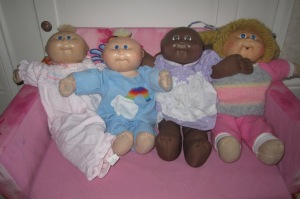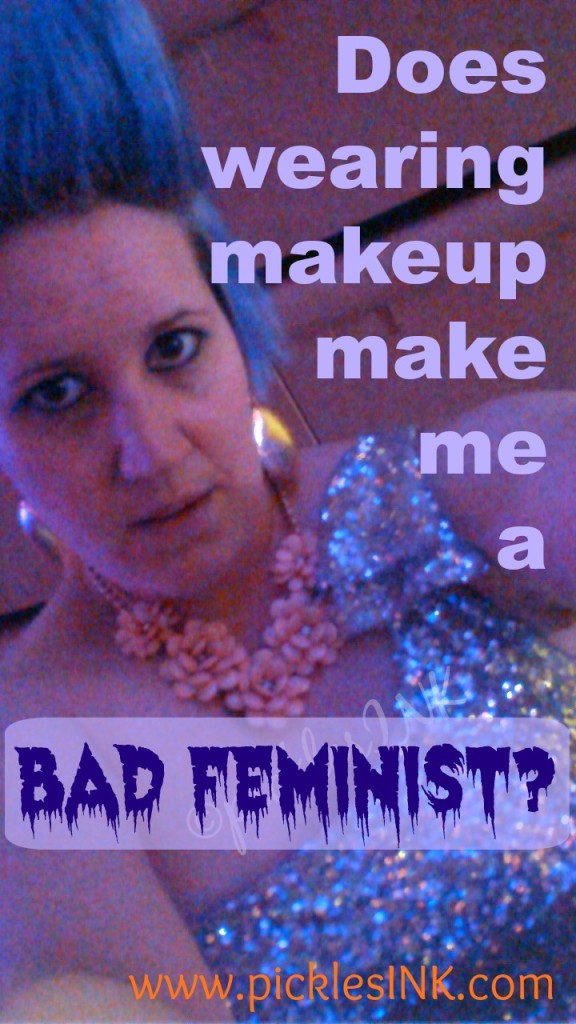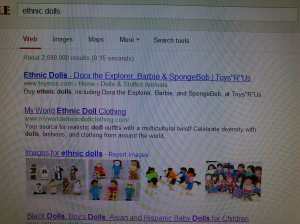A good friend posted this article to my Facebook timeline the other day, asking what I thought of it:
“New doll made with body image in mind”, Toronto Star, December 12, 2012

Two “Lottie” dolls by Arklu
Toronto Star, December 12, 2012
According to the article, Arklu, the company that makes ‘Lottie dolls’ “worked with two academics to work out the exact proportions of an average healthy 9-year-old. The scaled-down dolls don’t have breasts or super skinny waists, although their heads and eyes are enlarged.”
I had skimmed the article when I first came across it and remember thinking “Meh…cute dolls, nice concept, good price, but it’s been done,” but being asked specifically for an opinion compelled me to look a little deeper and I wound up tossing and turning all night thinking about my response, which was this:
As options for young girls go, I don’t hate them. I don’t think they will do any harm (or any more harm than any other doll, but I’ll get to that) but I don’t know that they’ll do the good the creators are hoping either. I know we as a society have heaped a lot of vitriol on Barbie, but I believe she is a symptom of our warped ideal body image, not the cause. When I was a little girl playing with Barbie, I saw her as a doll, not an image of an ideal woman. I never thought I would grow up to look like Barbie…I also never thought I would grow up to live in a Dream Castle (TM) or drive a bubble-gum pink motorhome.

Barbie in her Magical Motorhome (1990)
Aside from the weird physical proportions, Barbie (bearing in mind, I haven’t actually seen any of the movie/TV tie-ins, so I’m basing this solely on the commercials and characters from when I was a kid) is actually not unempowered, as female characters go. Except for that “Math is hard! Let’s go shopping!” talking Barbie debacle, Barbie usually represents an independent and successful woman – she has been a doctor and teacher, owns her own home, car, and motorhome, and though Ken shows up occasionally, he’s generally an unnecessary add-on. Yes, there is plenty of gender stereotyping (ie. Dr. Barbie spends all her time delivering cute babies and clearly has a weakness for short skits and pink stethoscopes , but the Lottie dolls obviously have not made clear inroads there either.

Dr. Barbie with 3 Baby Dolls (1995)
Special Edition Career Collection
On the other hand, these dolls do fill a void in the market – there are lots of baby dolls and lots of grown-up dolls (Barbie), but the only in-between little girl dolls traditionally have been TV characters like Dora or Doc McStuffins, or are prohibitively expensive (American Girl dolls, china dolls) so it is nice to have an affordable option that kids can personalize and relate to. In terms of the not wearing makeup, heels or jewelry, it’s a nice hook but to me the faces still have that same “glamour” look that defines all of these giant-headed, small-bodied dolls: Huge eyes, long straight hair, and perfect skin. Conclusion of the body-image section of my comment: I don’t think that these dolls are going to solve any problems, but they aren’t really going to create any new ones either.
Putting the body image piece aside, further study of the Lottie dolls brings up several other issues for me. First, on reading her website, we see that “Lottie” is clearly not suffering from any lack of funds, since her favourite activities include “pony flag races” and walks in “English country gardens” with her (presumably pedigreed) dog, “Biscuit the Beagle.” Lottie may be shaped like the average 9-year-old girl, but she seems to enjoy a very different class of leisure activities than the average girl who will be playing with her.
Second, and this is common to the whole “fashion doll” and for the most part the “doll in general” market – where are the boys? When are we going to meet Lottie’s brother Larry, who, I don’t know, loves playing soccer with Lottie and her friends when they’re finished with their English country garden picnics and fox hunts?
And third, and this is my very biggest issue – Traditionally, dolls are white. This is a HUGE problem for non-white children. There was a study originally done in the 1940’s and then re-created in 2006 by a high school student that demonstrated that when given 2 baby dolls, one black, one white, black children (boys and girls) overwhelmingly preferred the white doll and attributed positive attributes to it (“pretty,” “nice”) and negative attributes to the black doll (“bad”), and also identified the black doll when asked “Which doll looks the most like you?”

A Girl Like Me DVD Video Poster
© 2012 Kiri Davis
That bears repeating – the study was done first in the NINETEEN-FORTIES and repeated in TWO THOUSAND AND SIX and showed NO CHANGE in attitude. Please take 7 minutes and go and watch the extraordinarily powerful documentary by Kiri Davis. I’ll wait.
When I was about 3, Cabbage Patch Kids came out, and they were the first mainstream, popular manufacturer to actually offer a selection of black dolls.

Four Cabbage Patch Kids (1982)
©PicklesINK 2012
Now manufacturers are offering more selection when it comes to non-white dolls (or at least, black dolls – there is still very little out representing other ethnicities) but even those options only change the skin colour – they still have idealized, typically “white” features such as small, pointed noses, and long, smooth, glossy, straight hair, and these Lottie dolls are no exception (here’s that picture again). Does this look to you like the “average 9-year-old girl”?

Two “Lottie” dolls by Arklu
Toronto Star, December 12, 2012

Meteorologist Rhonda A. Lee
Consider the fact that a black meteorologist named Rhonda Lee was fired this November for responding – politely – to a viewer’s FB post saying that her short-cropped hair made her look like a “cancer patient” and she should wear a wig to avoid upsetting viewers (the viewer than continues on to say that while he is not racist, the world has “certain standerd [sic]” and asks, “if you come from a world of being poor, are you going to dress in rags?”);

News8 Anchor Jennifer Livingston
while at the same time a white news anchor, Jennifer Livingston, was hailed as a hero worldwide by responding to a letter saying that she should lose weight in order to be a better role model with a 4-minute on-air segment (she was interviewed by, among others, Ellen, Katie Couric, and Glamour magazine).
Rhonda Lee’s viewer is right – our world does have certain standards which have been set by public opinion and which are reinforced every day by, among other things, the dolls that are available for our children to play with. If Arclu wants their Lottie dolls to help to dismantle and reinvent these damaging standards, they have a little more thinking to do before they get to the heart of promoting positive self-image in the young girls (and boys) who are really at risk.
~ karyn
Do you like or loathe Barbie? Would you buy a Lottie doll?













